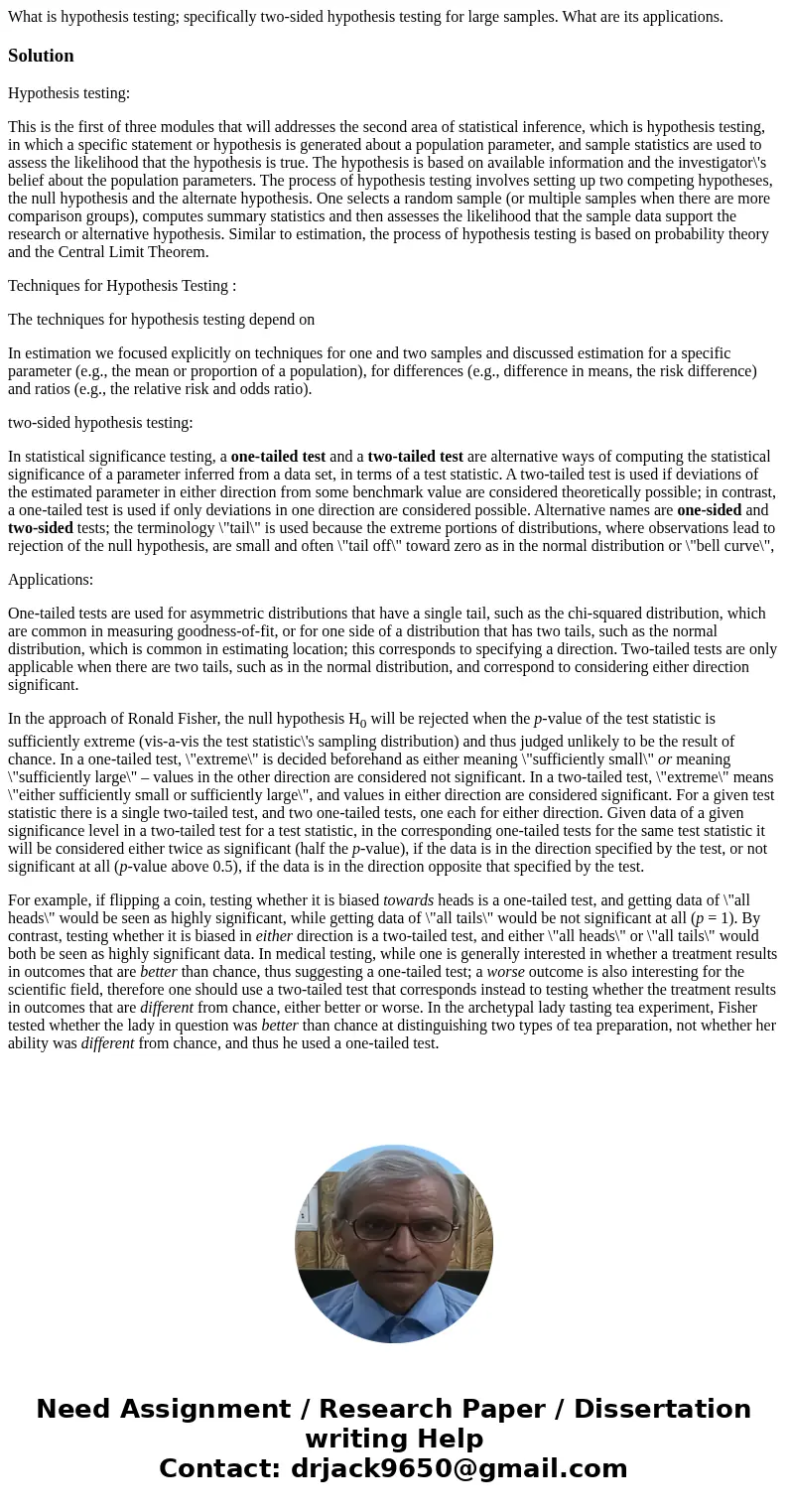What is hypothesis testing specifically twosided hypothesis
What is hypothesis testing; specifically two-sided hypothesis testing for large samples. What are its applications.
Solution
Hypothesis testing:
This is the first of three modules that will addresses the second area of statistical inference, which is hypothesis testing, in which a specific statement or hypothesis is generated about a population parameter, and sample statistics are used to assess the likelihood that the hypothesis is true. The hypothesis is based on available information and the investigator\'s belief about the population parameters. The process of hypothesis testing involves setting up two competing hypotheses, the null hypothesis and the alternate hypothesis. One selects a random sample (or multiple samples when there are more comparison groups), computes summary statistics and then assesses the likelihood that the sample data support the research or alternative hypothesis. Similar to estimation, the process of hypothesis testing is based on probability theory and the Central Limit Theorem.
Techniques for Hypothesis Testing :
The techniques for hypothesis testing depend on
In estimation we focused explicitly on techniques for one and two samples and discussed estimation for a specific parameter (e.g., the mean or proportion of a population), for differences (e.g., difference in means, the risk difference) and ratios (e.g., the relative risk and odds ratio).
two-sided hypothesis testing:
In statistical significance testing, a one-tailed test and a two-tailed test are alternative ways of computing the statistical significance of a parameter inferred from a data set, in terms of a test statistic. A two-tailed test is used if deviations of the estimated parameter in either direction from some benchmark value are considered theoretically possible; in contrast, a one-tailed test is used if only deviations in one direction are considered possible. Alternative names are one-sided and two-sided tests; the terminology \"tail\" is used because the extreme portions of distributions, where observations lead to rejection of the null hypothesis, are small and often \"tail off\" toward zero as in the normal distribution or \"bell curve\",
Applications:
One-tailed tests are used for asymmetric distributions that have a single tail, such as the chi-squared distribution, which are common in measuring goodness-of-fit, or for one side of a distribution that has two tails, such as the normal distribution, which is common in estimating location; this corresponds to specifying a direction. Two-tailed tests are only applicable when there are two tails, such as in the normal distribution, and correspond to considering either direction significant.
In the approach of Ronald Fisher, the null hypothesis H0 will be rejected when the p-value of the test statistic is sufficiently extreme (vis-a-vis the test statistic\'s sampling distribution) and thus judged unlikely to be the result of chance. In a one-tailed test, \"extreme\" is decided beforehand as either meaning \"sufficiently small\" or meaning \"sufficiently large\" – values in the other direction are considered not significant. In a two-tailed test, \"extreme\" means \"either sufficiently small or sufficiently large\", and values in either direction are considered significant. For a given test statistic there is a single two-tailed test, and two one-tailed tests, one each for either direction. Given data of a given significance level in a two-tailed test for a test statistic, in the corresponding one-tailed tests for the same test statistic it will be considered either twice as significant (half the p-value), if the data is in the direction specified by the test, or not significant at all (p-value above 0.5), if the data is in the direction opposite that specified by the test.
For example, if flipping a coin, testing whether it is biased towards heads is a one-tailed test, and getting data of \"all heads\" would be seen as highly significant, while getting data of \"all tails\" would be not significant at all (p = 1). By contrast, testing whether it is biased in either direction is a two-tailed test, and either \"all heads\" or \"all tails\" would both be seen as highly significant data. In medical testing, while one is generally interested in whether a treatment results in outcomes that are better than chance, thus suggesting a one-tailed test; a worse outcome is also interesting for the scientific field, therefore one should use a two-tailed test that corresponds instead to testing whether the treatment results in outcomes that are different from chance, either better or worse. In the archetypal lady tasting tea experiment, Fisher tested whether the lady in question was better than chance at distinguishing two types of tea preparation, not whether her ability was different from chance, and thus he used a one-tailed test.

 Homework Sourse
Homework Sourse